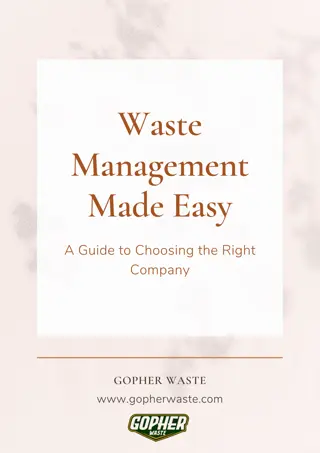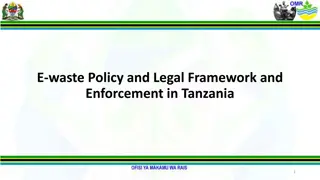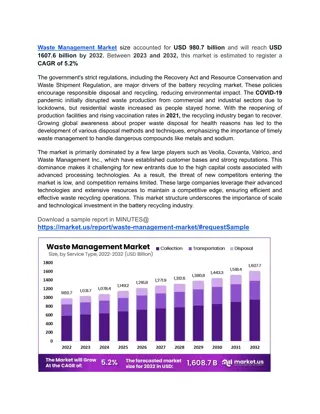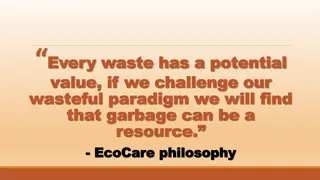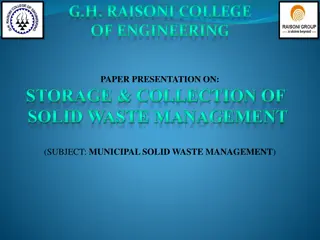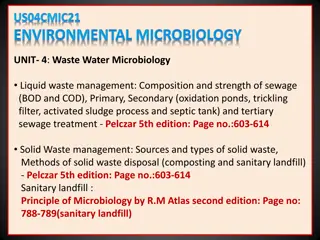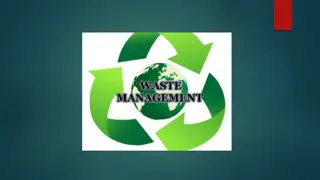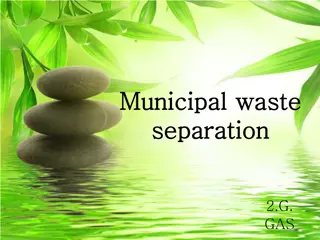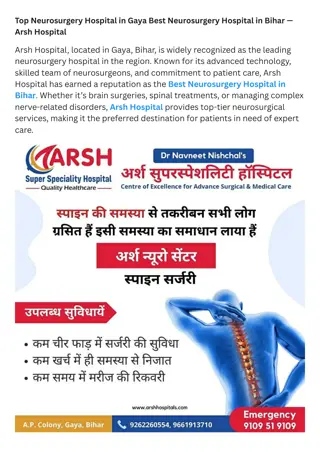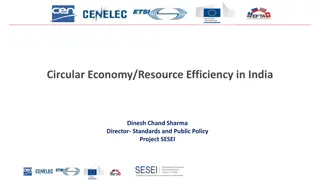Comprehensive Guide to Hospital Waste Management and Infection Control
Understanding and effectively managing hospital waste is crucial for infection control. Learn about different types of hospital waste, proper segregation and disposal methods, and minimizing risks of hazardous agents. This guide covers offensive waste, infectious waste, disposal protocols, and more.
Download Presentation

Please find below an Image/Link to download the presentation.
The content on the website is provided AS IS for your information and personal use only. It may not be sold, licensed, or shared on other websites without obtaining consent from the author.If you encounter any issues during the download, it is possible that the publisher has removed the file from their server.
You are allowed to download the files provided on this website for personal or commercial use, subject to the condition that they are used lawfully. All files are the property of their respective owners.
The content on the website is provided AS IS for your information and personal use only. It may not be sold, licensed, or shared on other websites without obtaining consent from the author.
E N D
Presentation Transcript
WASTE MANGMENT WASTE MANGMENT INFECTION CONTROL DEPARTMENT
Aim and objectives: Know different types of wastes. The proper segregation and disposal of Health Care Waste. Four steps of waste management. Minimize the risks of hazardous agents.
Types Of Hospital Waste Types Of Hospital Waste 1 1- -Health care non Health care non- - Risk Waste Risk Waste Offensive Definition: They represent no potential Domestic Packaging infections, chemical or radioactive risk. Recyclable Food Segregation and disposal: They are disposed in black plastic
Types Of Hospital Waste Types Of Hospital Waste 2 2- -Healthcare Risk Healthcare Risk Waste Waste Infectious waste Definition: They are contaminated/ potentially contaminated with infectious, chemical or radioactive . They should be handled & disposed off very carefully. Sharp waste Human and animal parts
Healthcare Risk Waste Healthcare Risk Waste 1- Infectious waste Definition: Waste potentially transmit an infectious disease due to its load of bacteria, viruses, parasites, fungi. Example : Cultures and stocks of infectious agents from laboratory work. Waste from surgery and autopsies (e.g. tissues, materials or equipment that have been in contact with blood or other body fluids). Waste soiled with human blood or other body fluids.
NOTES : NOTES : Urine and faeces are not considered infectious waste unless:- o The specimen of urine or faeces is for laboratory testing. o The urine or faeces is contaminated with visible blood. o The urine or faeces are infected with pathogenic micro- organisms. E.g. typhoid fever, enteritis, cholera.
Healthcare Risk Waste Healthcare Risk Waste Infectious waste (cont.,) Segregation and disposal: Handled in yellow plastic bags with Bio- hazard logo Highly infectious microbial cultures such as viruses, TB, Brucella, are to be collected in yellow bags suitable for pre treatment with autoclave with Highly Infectious Waste & Bio- hazard logo
Healthcare Risk Waste Healthcare Risk Waste 2-Human and Animal parts Definition: Organs, human parts, nonviable fetuses, placenta. Segregation and disposal: Handled in red plastic bags with Bio- hazard logo to be kept at mortuary until they are dealt with in accordance to Islamic Sharia (law). MC-ICD-P/12 Contaminated animal parts are handled in yellow plastic bags.
Healthcare Risk Waste Healthcare Risk Waste 3-Sharp waste Definition: Any device with acute rigid edges capable of cutting or piercing, E.g needles, syringes, scalpels, saws, blades and broken glass. Segregation and disposal: Collected in yellow puncture resistant sharp containers, with Bio- hazard logo ,date of first use and wall mounted . *Placed in point of care .
Safe disposal of waste Disposable bags &puncture resistant containers should be disposed when it is full. In case of the yellow puncture resistant containers are not full dispose after 7 days. Each type of waste should be separated from the other. MC-ICD-P/25
Management Four Steps Of Waste Management Four Steps Of Waste Management
1 1- - Segregation Segregation segregation segregation of wastes according to its color of wastes according to its color cod. cod.
Data Stickers o Stickers must be attached to the containers and bags of Stickers waste prior to their transportation to stores within the health care facility. oStickers should have the following data: Waste generator name Site name Type of waste Weight and the quantity of waste Date and time of collection transportation date and time to disposal facility
2. Handling 2. Handling Wear heavy utility gloves and shoes. Wash hands after handling waste & removing gloves. Containers should be collected when 3 /4 full. Waste carts should be leak proof and well covered.
3. Internal Storage 3. Internal Storage Place that is minimally accessible ,away from rodents, insects. Supply with cleaning equipment &PPE. Hazardous waste should not be stored longer than 2 days . It should be easily cleaned and disinfected , with good drainage.
4. 4. Disposal Disposal
Questions 1-all the urine and faeces consider as infectious waste : Yes No 2- after the mother delivery we dispose the placenta in : black bag Yellow bag Red bag 3-discard the sharp continuers when : full or after 7 days Over full Daily 4- health care non risk waste including food and packaging : Yes No 5-wher we should dispose the gloves contaminated by some blood : Sharp box Yellow bag Black bag




